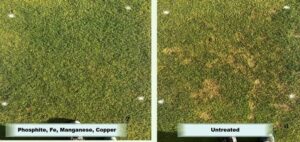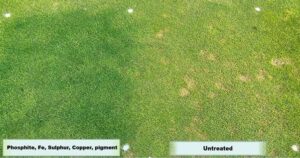Nutrients, our friends with benefits
Related Articles
From potassium to manganese, there are several elements and compounds that, apart from supplying essential nutrition, can have added benefits in enhancing plant health and suppressing disease, writes Dr John Dempsey.
As all sports turf managers, greenkeepers and groundsmen know, to provide top quality playing surfaces plant nutrition is vital. A balanced nutritional programme, tailored to the specific needs of the sports surface, and taking account of the nutritional status of the rootzone, is a key factor in successful turfgrass management.
Today though, I’m not going to get into all the specifics of nutrient programmes, there’s no shortage of information re that and certainly no shortage of advice as to what products to use!
What I am going to talk about is how many elements and compounds, apart from supplying essential nutrition, can also have added benefits in enhancing plant health, and stimulating resistance to not only abiotic stress, but biotic challenges and disease suppression.
Excessively high or low fertility contributes to disease pressures and we’re all now familiar with the recommendation of ‘Minimum Levels of Sustainable Nutrition’ (MLSN) and these have been shown to be very effective in providing accurate guidelines to the amount of nutrition required for turfgrass management.
But there are also numerous published data showing how nutritional inputs can have a direct effect on a plant’s response to stress, be it abiotic or biotic.
Here’s some examples:
• Ensuring there’s adequate levels of potassium > 36 ppm, and regular spoon-feeding of nitrogen during periods of high anthracnose pressure are important factors in reducing disease levels.
• Ferrous sulphate has been used by generations of greenkeepers to ‘harden the turf’. Studies at Myerscough College and at the Sports Turf Research Institute in the UK determined sequential applications during autumn / winter significantly reduced microdochium nivale infection.
• Manganese activates several enzymes essential for the generation of phenolic compounds, which are secondary metabolites vital for the plant’s defence against numerous stresses.
• Copper and sulphur have been used as fungicides for many years and can be very effective, especially when combined in a programme with other elements.
• Silica is often used by turf managers to ‘increase turgidity’ and green speed, but can, when applied as a foliar treatment, strengthen plant cell walls, reducing pathogen ingression. This has been shown to promote numerous other beneficial responses.
• Phosphite, a reduced form of phosphorus, now has much data to support its efficacy in reducing numerous diseases in many plant systems, including turfgrass.
• Salicylic acid is coming under increasing scrutiny as an elicitor of plant defence responses leading to systemic acquired resistance.
A point to note is that while the above all will have some effect on stress responses, it’s not until we start combining them into programmes that we will see significant disease suppression.
And this is borne out by research carried out by myself and others. Treatment programmes containing various nutrients have shown significant reductions of levels of anthracnose, microdochium, dollar spot, pythium and grey leaf spot.
Maintaining a balanced nutritional programme is crucial for healthy turfgrass. The correct programme will help provide the playing specifications for the many different sports surfaces.
But we should also be aware of the added benefits of using these elements and compounds which can be utilised as a further component of successful turf management.
Dr John Dempsey PhD was course manager at Royal Curragh Golf Club, Ireland’s oldest golf club, from 1993 to 2019. He has a first-class honours degree in turfgrass science from Myerscough College and a PhD in turfgrass pathology at the University of the West of England’s Centre for Research in Biosciences




























